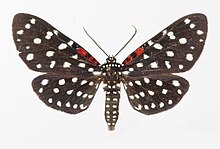
Manduca rustica, the rustic sphinx, is a moth of the family Sphingidae. The species was first described by Johan Christian Fabricius in 1775.

Glossata is a suborder of the Lepidoptera, containing all members that have a coilable proboscis; i.e., it includes all butterflies and the vast majority of moth species. The only non-Gloassatan moths are in the suborders Aglossata, Heterobathmiina, and Zeugloptera.

The white-shouldered house moth is a species of gelechioid moth. It belongs to the subfamily Oecophorinae of the concealer moth family (Oecophoridae), just like the brown house moth. Though several presumed congeners of E. sarcitrella were described, its genus Endrosis is currently understood to be monotypic.

Mocis frugalis, the sugarcane looper, is a moth of the family Erebidae. The species was first described by Johan Christian Fabricius in 1775. It is found in several parts of the world, including India, Sri Lanka, West African countries and other Oriental regions. The adult is a fruit piercer and a major pest of crops.

Composia is a genus of tiger moths in the family Erebidae. The genus was erected by Jacob Hübner in 1820.

Lomographa bimaculata, the white-pinion spotted, is a species of geometer moth. It belongs to the large geometer moth subfamily Ennominae, and therein to the tribe Baptini. It is – under its junior synonym – the type species of its genus Lomographa. It is also the type species of Bapta, a junior objective synonym of Lomographa and the namesake of the Baptini. The species was first described by Johan Christian Fabricius ion 1775.

Pseudargyrotoza conwagana is a moth of the family Tortricidae found in Asia and Europe. It was first described by the Danish entomologists, Johan Christian Fabricius in 1775.

Thysanoplusia orichalcea, the slender burnished brass, is a moth of the family Noctuidae. The species was first described by Johan Christian Fabricius in 1775. It is a polyphagous pest of vegetable crops that originated in Indonesia, from where it spread to Europe, South Asia, India, Sri Lanka, Africa, Australia and New Zealand. In northern Europe it is a migrant species.

Harpyia milhauseri, the tawny prominent, is a moth of the family Notodontidae. The species was first described by Johan Christian Fabricius in 1775. It is mainly found in central Europe.

Anomis flava, the cotton looper, tropical anomis or white-pupiled scallop moth, is a moth of the family Erebidae. The species was first described by Johan Christian Fabricius in 1775. It is found in large parts of the world, including China, Hawaii, São Tomé and Príncipe, the Society Islands, Thailand, New Zealand, and Australia. Subspecies Anomis flava fimbriago is found in North America.










